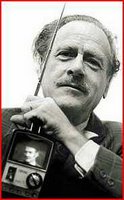 A dialog with the late Marshall McLuhan.
A dialog with the late Marshall McLuhan.DR: Civil War history from about 1960 on has been a slick product delivered to its public on a news broadcast model – “And that’s the way it is.” Its best-selling motifs became endlessly reworked, until motif gave way to clichés.
MM: The world of the cliché is itself environmental since nothing can become a cliché until it has pervaded some world or other. It is at the moment of pervasiveness that the cliché becomes invisible.
DR: Which causes that startled reaction from readers when the Civil War author leaves the certainties we all “know” behind. The newscast model has been remarkably robust despite sweeping changes in information technology…
MM: …they still have the illusion that the new developments are to be fitted into the old space or environment.
DR: You see that with LSU publishing a conventional book review magazine online; with authors blogging whole chapters of their print books; with the same logic of ink and paper costs limiting an online catalog as if it were a print catalog; with email being used as junk mail.
MM: Under electric conditions the content tends, however, toward becoming environmental itself.
DR: The great commonplace of the dotcom era was that it was all about content; the Internet was its content, not technology. But by publishing ACW content on the Internet, one also becomes highly aware of aspects to old style Civil War publishing.
MM: When an environment is new, we perceive the old one for the first time.
DR: And we can perceive it critically, from outside and above.
MM: An environment is naturally of low intensity or low definition. That is why it escapes observation. Anything that raises the environment to high intensity … turns the environment to an object of attention. When it becomes an object of attention, it assumes the character of an antienvironment or an art object.
DR: Subject to the criticism we would bestow on an art object.
MM: Art and education were presented to the public as consumer packages for their instruction and edification. The members of the mass audience are immediately involved in art and education as participants and co-creators rather than as consumers.
DR: Why distinguish between: the “public” of the Centennial era and the mass audience of electronic media times?
MM: The Mass does not consist of separate individuals, but of individuals profoundly involved in one another. This involvement is a function not of numbers but of speed. The age of the mass audience is thus far more individualistic than the preceding age of the public.
DR: And these engaged communities of interest, communicating frequently, at high speed, are colliding with a world still passively ingesting units of edification.
MM: The feedback loop plays all sorts of tricks to confound the single-plane and one-way direction of thought and action....
DR: ... but the loop plays tricks on us all. Imagine media interaction with a professor, student, archivist, or corporate publisher: this class of participant is self-censored and drags chains of bondage at the bottom of every email sent. The behaviour of such restricted classes of participants is going to transform any media environment they enter. The environment fogs over - its contours become vague.
MM: In an age of accelerated change, the need to perceive the environment becomes urgent.
(DR: From Essential McLuhan by McLuhan and Zingaro, Toronto, Anansi, 1995. All quotes from the chapter “The Emperor’s New Clothes.” Emphasis in the original.)



